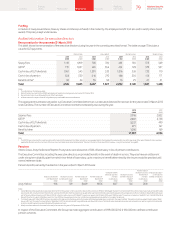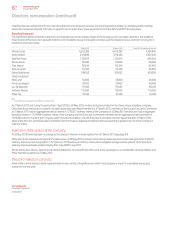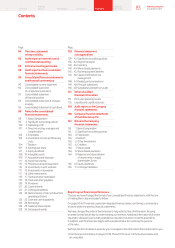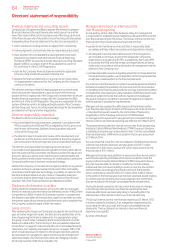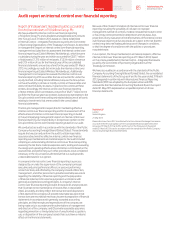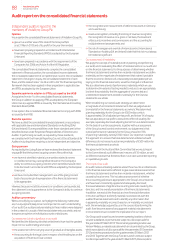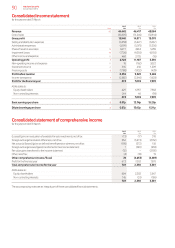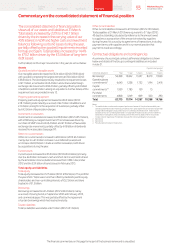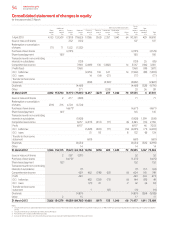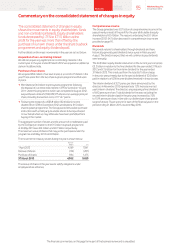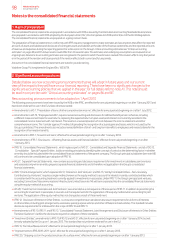Vodafone 2013 Annual Report Download - page 90
Download and view the complete annual report
Please find page 90 of the 2013 Vodafone annual report below. You can navigate through the pages in the report by either clicking on the pages listed below, or by using the keyword search tool below to find specific information within the annual report.
Independent auditor’s report to the
members of Vodafone Group Plc
Opinion
In our opinion the consolidated financial statements of Vodafone Group Plc:
a give a true and fair view of the state of the Group’s affairs
as at 31 March 2013 and of its prot for the year then ended;
a have been properly prepared in accordance with International
Financial Reporting Standards (IFRSs) as adopted by the European
Union; and
a have been prepared in accordance with the requirements of the
Companies Act 2006 and Article 4 of the IAS Regulation.
The consolidated nancial statements comprise the consolidated
statement of nancial position, the consolidated income statement,
the consolidated statement of comprehensive income, the consolidated
statement of changes in equity, the consolidated statement of cash
ows, and the related notes 1 to 26 and A1 to A9. The nancial reporting
framework that has been applied in their preparation is applicable law
and IFRSs as adopted by the European Union.
Separate opinion in relation to IFRSs as issued by the IASB
As explained in note 1 to the consolidated nancial statements,
the Group in addition to applying IFRSs as adopted by the European
Union, has also applied IFRSs as issued by the International Accounting
Standards Board (IASB).
In our opinion the consolidated nancial statements comply with IFRSs
as issued by the IASB.
Basis for opinions
We have audited the consolidated nancial statements in accordance
with applicable law and International Standards on Auditing (ISAs)
(UK and Ireland). Our responsibilities under those standards are further
described below under Respective Responsibilities of Directors and
Auditor. In performing our audit, as required by those standards,
we complied with the Financial Reporting Council’s Ethical Standards for
Auditors including those requiring us to be independent and objective.
Going concern
As required by the Listing Rules we have reviewed the directors’ statement
on page 84 that the business is a going concern. We confirm that:
a we have not identied material uncertainties related to events
or conditions that may cast signicant doubt on the Company’s
abilityto continue as a going concern which we believe would need
to be disclosed in accordance with IFRSs as adopted by the European
Union; and
a we have concluded that management’s use of the going concern
basis of accounting in the preparation of the nancial statements
to be appropriate.
However, because not all future events or conditions can be predicted,
this statement is not a guarantee as to the Company’s ability to continue
as a going concern.
Auditor commentary
Without modifying our opinion, we highlight the following matters that
are, in our judgment, likely to be most important to users’ understanding
of our audit. Our audit procedures relating to these matters were designed
in the context of our audit of the nancial statements as a whole, and not
to express an opinion on individual accounts or disclosures.
Our assessment of risks signicant to our audit
We identied the following risks that we believe to have had the greatest
impact on our audit strategy and scope:
a the assessment of the carrying value of goodwill and intangible assets;
a the accounting for the legal claim in respect of withholding tax on the
acquisition of Hutchison Essar Limited;
a the recognition and measurement of deferred tax assets in Germany
and Luxembourg;
a revenue recognition, including the timing of revenue recognition,
the recognition of revenue on a gross or net basis, the treatment
of discounts, incentives and commissions and the accounting for
multiple element arrangements; and
a the risk of management override of internal control. International
Standards on Auditing (UK and Ireland) state that this risk must always
be treated as signicant.
Our assessment of materiality
We apply the concept of materiality both in planning and performing
our audit, and in evaluating the effect of misstatements on our audit and
on the nancial statements. For the purposes of determining whether
the nancial statements are free from material misstatement we dene
materiality as the magnitude of misstatement that makes it probable
that the economic decisions of a reasonably knowledgeable person,
relying on the nancial statements, would be changed or inuenced.
We also determine a level of performance materiality which we use
to determine the extent of testing needed to reduce to an appropriately
low level the probability that the aggregate of uncorrected and
undetected misstatements exceeds materiality for the nancial
statements as a whole.
When establishing our overall audit strategy, we determined
a magnitude of uncorrected misstatements that we judged would
be material for the nancial statements as a whole. We determined
planning materiality for the Group to be £500 million, which
is approximately 5% of adjusted pre-tax prot, and below 1% of equity.
We use adjusted pre-tax prot to exclude the effect of volatility (for
example, separately disclosed adjusting items) from our determination.
On the basis of our risk assessments, together with our assessment
of the Group’s overall control environment, our judgement is that
overall performance materiality for the Group should be 70%
of planning materiality, namely £350 million. Our objective in adopting
this approach is to ensure that total detected and undetected audit
differences do not exceed our planning materiality of £500 million for
the nancial statements as whole.
We agreed with the Audit and Risk Committee that we would report
to the Committee all audit differences in excess of £10 million, as well
as differences below that threshold that, in our view, warranted reporting
on qualitative grounds.
The scope of our audit
An audit involves obtaining evidence about the amounts and disclosures
in the nancial statements sufcient to give reasonable assurance that
the nancial statements are free from material misstatement, whether
caused by fraud or error. This includes an assessment of: whether
the accounting policies are appropriate to the Group’s circumstances
and have been consistently applied and adequately disclosed;
the reasonableness of signicant accounting estimates made by the
directors; and the overall presentation of the nancial statements.
In addition, we read all the nancial and non-nancial information
in the Annual Report to identify material inconsistencies with the
audited nancial statements and to identify any information that
is apparently materially incorrect based on, or materially inconsistent
with, the knowledge acquired by us in the course of performing the
audit. If we become aware of any apparent material misstatements
or inconsistencies we consider the implications for our report.
Our Group audit scope focused on seven operating locations, of which
six were subsidiaries or joint ventures subject to a full scope audit for
the year ended 31 March 2013. The remaining operating location was
Verizon Wireless, a material associate which is not controlled by the Group,
which was subject to a full scope audit for the year ended 31 December
2012 and review procedures for the quarters ended 31 March 2012
and 2013. Together with the Group Functions, which were also subject
to a full scope audit for the year ended 31 March 2013, these locations
Audit report on the consolidated nancial statements
88 Vodafone Group Plc
Annual Report 2013



